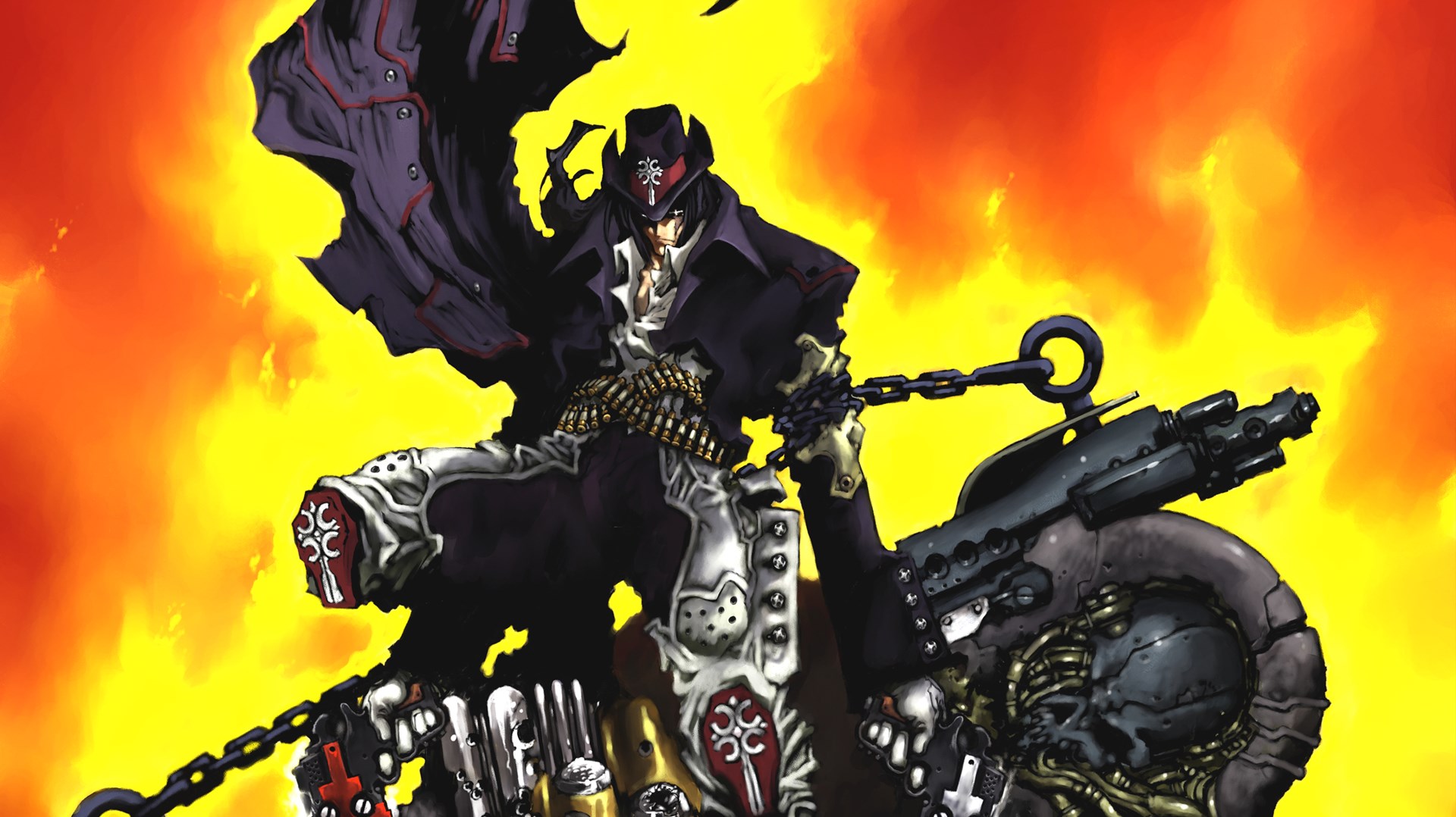Christmas is around the corner and I’ve realized I have yet to play a “Christmas” themed game, so I figured “why not get in the holiday mood” by playing a very ambiguous “holiday” title if you can call it that? Honestly, calling Gungrave a “holiday video game” is as much of a stretch as trying to convince others that Die Hard 2 is a “holiday movie” (it is, by the way).
Gungrave’s opening cutscene takes place in a snow-ridden street with a young girl carrying a briefcase as a trail of blood follows. The scene then shifts to a doctor who prefers to go by “T,” and the hulking brute of a protagonist with few words, Beyond the Grave. Upon delivering the guns, Grave sets out to do what he does best; Shoot things. The title is called Gungrave after all. Time to spread the holiday cheer as wide as the bullets from Grave’s handguns.

Before I go deep into the mechanics, here’s the real reason why I wanted to take a look back at Gungrave. It’s fascinating that a 2002 over-the-shoulder third-person shooter set the precedent for games like Gears of War. This era of shooters was always interesting as there wasn’t a blueprint to follow. It was always what felt “aesthetically pleasing” to play and watch. I mentioned this more during my Star Wars Republic Commando coverage. Much like that game, this will also be the first time I’ve ever played any of the Gungrave titles.
The second reason is something that’s purely coincidental yet equal parts amusing. The story and character design of Gungrave are credited to Yasuhiro Nightow, the creator of Trigun. There are shared aesthetics between the two games, specifically the similarities in design between Vash the Stampede and Grave. Gungrave’s main composer, Tsuneo Imahori, had also worked on Trigun in what I’d consider one of the best anime soundtracks ever composed.

Gungrave's success would premiere an anime based on the game, a direct sequel in Gungrave Overdose, and of course the newest title, Gungrave G.O.R.E. Two of Nightow’s largest works, Trigun and Gungrave, both see a revival meer months from each other with drastic changes in design and the blessings of the original creator. Looking back at my first impression of the first episode of Trigun Stampede, I’m coming into this blind that G.O.R.E would give the same respect to Gungrave but it’s too early to tell.
I wanted to start from the beginning and play the one game that has eluded my childhood all this time. I always thought that Gungrave’s design, especially for a 2002 game, was a cut above the rest. Cel shading in games wasn’t uncommon, with Jet Set Radio helping pioneer as a valid art direction. Gungrave, with a staff of skilled creatives in the anime industry, captured the “playable anime experience.” Muzzle flashes are abundant, Grave leaps and shoots like Max Payne himself, and explosions are created in a spectacular manner. Visually, the game has most certainly stood the test of time. The gameplay however is a mixed bag.

Gungrave feels like an on-rails shooter, similar to Time Crisis and Dynamite Cop, except you’re desperately spamming the L1 button to lock on to enemies only to rain a hailstorm of bullets. If you’re within melee range, you can attack enemies with your steel case, leaving players with an option to defend themselves within close range. The star of the show is the guns and you’re encouraged to shoot as if you have infinite bullets. It just so happens that not only do you have infinite bullets, but the enemies are just as eager to fill Grave up with lead as well.
It comes off as an “animated ‘John Woo’ flick,” which is ironic considering Stranglehold would release a few years later. The levels are short, with the general plot revealed in between via cutscenes. Each level is essentially “Find this target, kill them, and anyone else” while getting from Point A to Point B. The movement is clunky which is understandable as Grave is a big guy. Even during cutscenes, he moves with a rigidness that feels like The Incredible Hulk with guns. Once you get the hang of it, however, it’s a fun albeit short bullet festival.

In most games of this nature, you would use the right analog stick to turn the camera and aim. Not so in Gungrave. As you turn with the left stick, so too does the camera, making target lock even more important. Remember how old-school shooters like Doom were a "point in a general direction and aim automatically?" Gungrave has a similar aiming function here. By the second level, it's easy to grasp, combined with using the Circle button to run and the Cross button to dive. For some reason, pressing Cross without inputting a directing will cause Grave to neutral jump. Even more confusing is that Grave seems to do more damage with his regular gun attacks while not moving, opting to wave them around like Reaper from Overwatch, a full decade before the game was even considered.
Triangle allows Grave to use his Demolition Shot, accessible via the skull icon on the upper left side. These can be anything from a powerful missile to an AOE spread attack. It's up to the player to decide which Demolition Shot is the best at any given time. Unfortunately, the game concludes as things begin to ramp up. Aside from its clunky controls, perhaps what the original Gungrave is best known for is its short length. There are a total of six stages, each taking no more than 10 minutes to complete, totaling the entire game just a little over an hour. For a PS2-era game, this was to be expected from action-based titles.

The biggest downgrade I can give Gungrave is that its ambitions are rather high for what is essentially "Do the same thing for six levels." Of course, there are bosses to break the monotony but the story is what's the most intriguing. As I feel the plot is Gungrave's strongest suit, I won't spoil too much. Essentially, the person you're chasing, Harry, was once a childhood friend of Grave, both raised by Big Daddy under the same organization. Harry betrays Grave and Big Daddy with plans on executing the latter, kills Grave for protecting Big Daddy, and Grave is now reborn to enact revenge. Hence, the new name Beyond the Grave. Oh, and the girl in red, Mika, serves as Grave's humanity check.
Despite being undead, he finds purpose in wanting to protect this girl, defining his character trait of being a selfless individual despite his appearance. Fans of Trigun were already itching to compare Beyond the Grave with Nicholas D Wolfwood and you wouldn't be too wrong. Both characters have a mysterious past and seek to make amends while carrying large rifles on their backs. As the story unravels, Grave and Harry are basically a modern noir "Vash and Knives Lite Edition."

The familiarity of Nightow's previous works along with the impressive visuals and character designs was what gave Gungrave a lasting impression, despite it being as short as a game from the Simple series on a larger budget. Gungrave was always more than just "another action shooter," as Nightow had future plans for Grave. As I mentioned earlier, an anime spinoff detailing the origins of Grave was released soon after.
The anime was quite popular, already having the credentials of Trigun. So much so, that some assumed the original Gungrave was based on the anime and not the other way around. Riding the hype of Gungrave, Nightow would get started on the sequel, Gungrave: Overdose. However, this game would prove to be quite different from the original in many different ways. The ball was in their court and it'll be interesting to see what comes of it.


